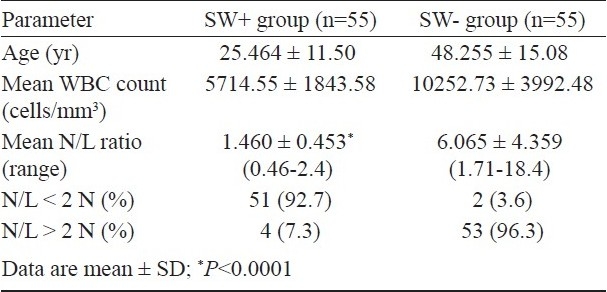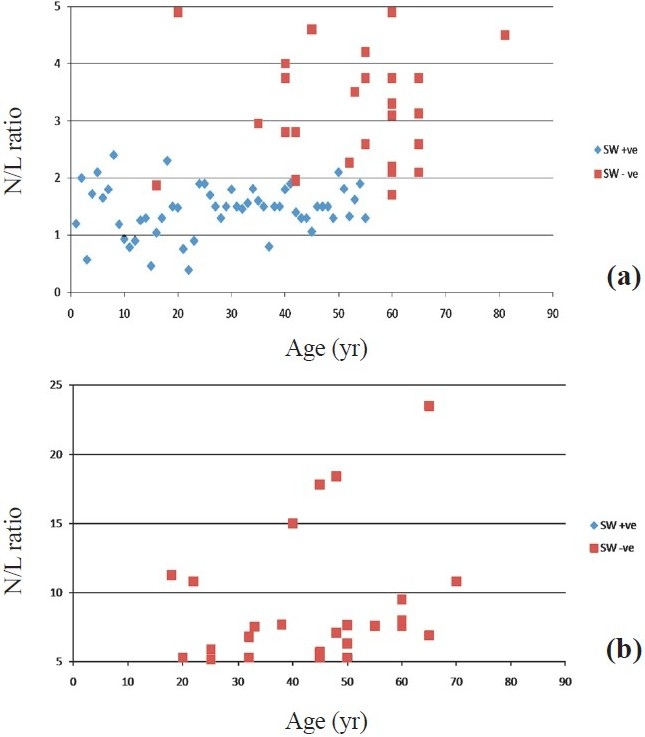Abstract
Background & objectives:
During an outbreak of influenza like illness throat swab culture and virus isolation are done to identify causal virus, and it may cause a significant delay in diagnosis and isolation. There is a need to determine a sensitive laboratory parameter which could play a major role in identifying H1N1 infection among patients presenting with influenza like symptoms. We undertook this study to determine a laboratory parameter to identify swine influenza infection amoung patients presenting with influenza like symptoms while awaiting throat swab culture and virus isolation reports.
Methods:
This retrospective study was conducted on patients presenting to A.P TB and Chest Hospital, Hyderabad, with swine influenza symptoms during September-October 2009. They were divided into swine flu positive (SW+) and swine flu negative (SW-) groups, based on their throat swab culture reports and laboratory data. Neutrophils to lymphocyte (N/L) ratio was calculated for every patient and also mean N/L ratio for two groups. Mean WBC count was also noted for both groups.
Results:
There were 55 patients in each group. The WBC count in SW+ group varied from 3000 to 10600 cells/mm3 (mean 5714), while in SW- group it varied from 4500 to 14300 cells/mm3 (10252). The N/L ratio was less than two for 92.7 per cent of patients in SW+ group and for 3.63 per cent patients in SW- group. N/L ratio < 2 as an indicator for swine flu had a sensitivity of 92.7 per cent and specificity of 96.36 per cent. It has a positive predictive value of 96.22 per cent and a negative predictive value of 92.8 per cent.
Interpretation & conclusions:
N/L < 2 along with a decrease in WBC count can be used as a screening tool in patients presenting with influenza like symptoms, while awaiting throat swab culture reports for confirmation.
Keywords: H1N1 influenza, lymphocytes, neutrophils, screening tool, swine influenza
In April 2009, a novel influenza A (H1N1) virus was determined to be the cause of influenza like illness in two children in the United States during March and April 2009 and the cause of respiratory illness in Mexico1. The virus quickly spread worldwide through human to human transmission. The first case in India was detected in May 2009 in a 23 yr old man who flew from New York to Hyderabad2. In humans three subtypes of influenza A viruses viz., H1N1, H2N2, and H3N2, resulting from genomic reassortment have been detected3. H1N1 infection may present with symptoms like cough, rhinorrhea, sore throat, fever, malaise, headache, shortness of breath and chills4 and results in various degrees of infection classified into mild to severe to fatal5. Usually reverse transcriptase polymerase chain reaction (RT- PCR) and throat swab culture are done which are time consuming procedures, and result in significant delay in confirmation of suspected cases and their isolation.
We conducted a retrospective study of patients who presented to A.P TB and Chest Hospital, Hyderabad, with symptoms of influenza like illness during September to October 2009. The aim of the study was to find out a sensitive laboratory parameter which could play a major role in identifying H1N1 virus infection among patients presenting with influenza like symptoms while awaiting throat swab culture reports.
Material & Methods
This retrospective study was conducted on patients who came to A.P TB and Chest Hospital, Hyderabad, during September to October 2009 and presenting with any two or more of the symptoms which included cough, sore throat, fever, rhinorrhea, malaise, headache, shortness of breath and chills. All other patients who had productive cough indicating a bacterial infection or any symptoms other than those mentioned above or a positive chest X-ray indicating a lower respiratory tract infection were excluded. A throat swab culture report (obtained from National Institute of Communicable Diseases, now National Centre for Disease control, Delhi) of each patient was obtained. Patients who did not have a throat swab culture report were also excluded from the study. The patients, who had a positive throat swab culture report for swine flu H1N1 virus were grouped as swine flu positive group (SW+ group) which included 55 patients. Fifty five randomly selected patients who had a negative throat swab culture report were labeled as swine flu negative group (SW- group). Some of them were H1N1 negative but influenza A positive, while some were negative for both H1N1 and influenza A. Laboratory data were collected for each patient in two groups which included complete blood picture (CBP), ESR and chest X-ray. Neutrophils to lymphocyte ratio (N/L ratio) was calculated for each patient. The mean N/L ratio and mean WBC count for both groups were also calculated. The data were analyzed by unpaired t-test.
Results & Discussion
There was a relative decrease in WBC count of patients in SW+ group compared to patients in SW- group which was consistent with the earlier studies6–8. The WBC count in SW+ group varied from 3000 to 10600 (mean 5714), while in SW- group it varied from 4500 to 14300 (mean 10252). The N/L ratio was less than two for 92.7 per cent of patients in SW+ group. It was greater than two for 96.3 per cent patients in SW- group (Table).
Table.
Age, WBC count and N/L ratios of both SW+ and SW− groups

The age distributions of the two groups and their individual N/L ratios are plotted on a scatter plot (Fig.). The age distribution in SW- group was slightly higher than that of SW+ group, probably indicating resistance to H1N1 virus in older individuals (especially those aged greater than 60 yr) as indicated in earlier studies9. Only four patients in SW+ group had N/L ratio greater than two, while only two patients of SW- group had the ratio less than two. N/L < 2 as an indicator for swine influenza had a positive predictive value of 96.22 per cent and a negative predictive value of 92.98 per cent. It has a sensitivity of 92.72 per cent and a specificity of 96.36 per cent. Data were analyzed using unpaired ‘t’ test.
Fig.

(a) Scatter plot for N/L ratios 0 to 5 for SW +ve and SW -ve groups, (b) Scatter plot for N/L ratios 5 to 25 for SW +ve and SW -ve groups.
The majority of SW+ group had an N/L ratio less than two, while that in SW- group it was greater than two. The SW- group included cases who were swine flu negative but influenza A positive and some were both influenza A and swine flu (H1N1) negative. These were probably due to other viruses causing flu like illness, for example, influenza B or respiratory syncytial virus (RSV), etc. It was necessary to include viruses other than H1N1, which present with influenza like symptoms. RT-PCR was not done to identify the type of virus for every case in SW- group as it was not necessary because the aim of the study was to differentiate between swine influenza H1N1 positive cases and all other viral respiratory illness presenting with similar complaints. All swine flu positive patients had low lymphocyte counts. The average lymphocyte count for SW+ group was 5714 cells/mm3 while that of SW- group was 10252 cells/mm3. This may be probably due to lymphotoxic effects of the swine flu virus. Earlier studies indicated the role of lymphopenia, monocytosis, and lymphocyte to monocyte ratio in detecting swine influenza10,11, but the N/L ratio less than two observed in this study has not been reported. N/L ratio as a screening tool was found to be sensitive and specific for swine influenza virus infetion and may serves as a rapid screening test. It is suggested that in patients presenting with influenza like symptoms N/L ratio and low lymphocyte count together can be used as a screening tool for swine influenza. When all the three parameters i.e., influenza like symptoms, low lymphocyte count and N/L ratio less than two are taken into consideration, these are highly indicative of H1N1 infection. It can also be used along with other influenza detection tests like rapid influenza test (RIT), to increase the possibility of diagnosing influenza virus.
In conclusion, in a patient presenting with two or more of influenza like symptoms (cough, sore throat, fever, rhinorrhea, malaise, headache, shortness of breath, chills) a decrease in WBC count and an N/L ratio less than 2 indicate the possibility of swine flu. But the final diagnosis must be based on throat swab culture and virus isolation. N/L ratio less than two may serve an excellent screening tool for isolation while awaiting throat swab culture reports for conformation of the diagnosis. It is time saving and cost-effective procedure. The anti-viral treatment can also be started early thus reducing the complications and mortality due to delayed treatment. It would be especially helpful when there are a large number of suspected cases or in areas where the facilities for throat swab culture are not available.
Weather the diagnostic rule described in the present study exclusively applies to patients with swine influenza needs to be evaluated in a larger sample.
Acknowledgments
Authors thank superindentant of A.P TB and Chest Hospital, Hyderabad for valuable guidance.
References
- 1.CDC. Outbreak of Swine- origin influenza (H1N1) virus infection- Mexico. MMWR Morb Mortal Wkly Rep. 2009;58:467–70. [PubMed] [Google Scholar]
- 2.Press Information Bureau, Government of India. [accessed on August 8, 2011]. Available from: http://pib.nic.in/newsite/erelease.aspx?relid=48762 .
- 3.Michaelis M, Doerr HW, Cinatl J., Jr An influenza A H1N1 virus revival - pandemic H1N1/09 virus: Infection. 2009;37:381–9. doi: 10.1007/s15010-009-9181-5. [DOI] [PubMed] [Google Scholar]
- 4.Girard MP, Tam JS, Assossou OM, Kieny MP. The 2009 A (H1N1) influenza virus pandemic: A review: Vaccine. 2010;28:4895–902. doi: 10.1016/j.vaccine.2010.05.031. [DOI] [PubMed] [Google Scholar]
- 5.Garten RJ, Davis CT, Russell CA, Shu B, Lindstrom S, Balish A, et al. Antigenic and genetic characteristics of swine-origin 2009 A(H1N1) influenza viruses circulating in humans. Science. 2009;325:197–201. doi: 10.1126/science.1176225. [DOI] [PMC free article] [PubMed] [Google Scholar]
- 6.Cunha BA, Pherez FM, Schoch P. Diagnostic importance of relative lymphopenia as a marker of swine influenza (H1N1) in adults. Clin Infect Dis. 2009;49:1454–6. doi: 10.1086/644496. [DOI] [PubMed] [Google Scholar]
- 7.Cao B, Li XW, Mao Y, Wang J, Lu HZ, Chen YS, et al. National Influenza A Pandemic (H1N1) 2009 Clinical Investigation Group of China: Clinical features of the initial cases of 2009 pandemic influenza A (H1N1) virus infection in China. N Engl J Med. 2009;361:2507–17. doi: 10.1056/NEJMoa0906612. [DOI] [PubMed] [Google Scholar]
- 8.Saha A, Jha N, Dubey NK, Gupta VK, Kalaivani M. Swine-origin influenza A (H1N1) in Indian children. Ann Trop Paediatr. 2010;30:51–5. doi: 10.1179/146532810X12637745452031. [DOI] [PubMed] [Google Scholar]
- 9.Skountzou I, Koutsonanos DG, Kim JH, Powers R, Sathyabhama L, Masseoud F, et al. Immunity to pre- 1950 H1N1 Influenza viruses confers cross-protection against the pandemic swine origin 2009 A (H1N1) influenza virus. J Immunol. 2010;185:1942–9. doi: 10.4049/jimmunol.1000091. [DOI] [PMC free article] [PubMed] [Google Scholar]
- 10.Merekoulias G, Alexopoulos EC, Belezos T, Panagiotopoulou E, Jelastopulu DM. Lymphocyte to monocyte ratio as a screening tool for influenza. PLoS Curr. 2010;2:154. doi: 10.1371/currents.RRN1154. [DOI] [PMC free article] [PubMed] [Google Scholar]
- 11.Cunha BA, Syed U, Stroll S, Mickail N, Laguerre M. Winthrop-University Hospital Infectious Disease Division's swine influenza (H1N1) pneumonia diagnostic weighted point score system for hospitalized adults with influenza-like illnesses (ILIs) and negative rapid influenza diagnostic tests (RIDTs) Heart Lung. 2009;38:534–8. doi: 10.1016/j.hrtlng.2009.09.005. [DOI] [PMC free article] [PubMed] [Google Scholar]


